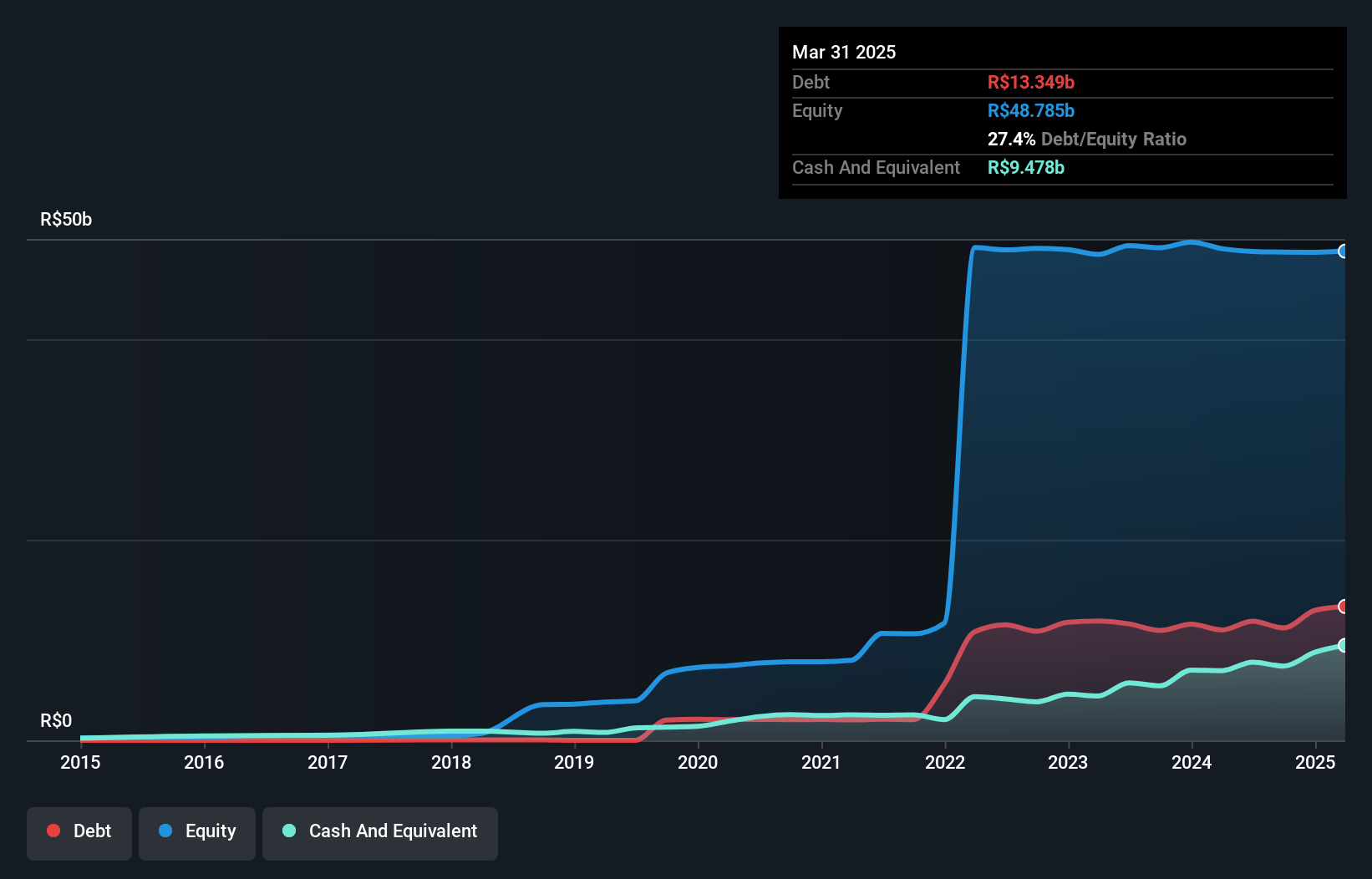- Brazil
- /
- Healthcare Services
- /
- BOVESPA:HAPV3
These 4 Measures Indicate That Hapvida Participações e Investimentos (BVMF:HAPV3) Is Using Debt Extensively

Some say volatility, rather than debt, is the best way to think about risk as an investor, but Warren Buffett famously said that 'Volatility is far from synonymous with risk.' So it might be obvious that you need to consider debt, when you think about how risky any given stock is, because too much debt can sink a company. Importantly, Hapvida Participações e Investimentos S.A. (BVMF:HAPV3) does carry debt. But the real question is whether this debt is making the company risky.
When Is Debt A Problem?
Generally speaking, debt only becomes a real problem when a company can't easily pay it off, either by raising capital or with its own cash flow. In the worst case scenario, a company can go bankrupt if it cannot pay its creditors. However, a more frequent (but still costly) occurrence is where a company must issue shares at bargain-basement prices, permanently diluting shareholders, just to shore up its balance sheet. Of course, debt can be an important tool in businesses, particularly capital heavy businesses. The first step when considering a company's debt levels is to consider its cash and debt together.
What Is Hapvida Participações e Investimentos's Debt?
You can click the graphic below for the historical numbers, but it shows that as of March 2025 Hapvida Participações e Investimentos had R$13.3b of debt, an increase on R$11.0b, over one year. However, because it has a cash reserve of R$9.48b, its net debt is less, at about R$3.87b.

A Look At Hapvida Participações e Investimentos' Liabilities
The latest balance sheet data shows that Hapvida Participações e Investimentos had liabilities of R$7.76b due within a year, and liabilities of R$19.8b falling due after that. Offsetting these obligations, it had cash of R$9.48b as well as receivables valued at R$2.69b due within 12 months. So it has liabilities totalling R$15.4b more than its cash and near-term receivables, combined.
This deficit is considerable relative to its market capitalization of R$18.2b, so it does suggest shareholders should keep an eye on Hapvida Participações e Investimentos' use of debt. Should its lenders demand that it shore up the balance sheet, shareholders would likely face severe dilution.
View our latest analysis for Hapvida Participações e Investimentos
We use two main ratios to inform us about debt levels relative to earnings. The first is net debt divided by earnings before interest, tax, depreciation, and amortization (EBITDA), while the second is how many times its earnings before interest and tax (EBIT) covers its interest expense (or its interest cover, for short). The advantage of this approach is that we take into account both the absolute quantum of debt (with net debt to EBITDA) and the actual interest expenses associated with that debt (with its interest cover ratio).
While Hapvida Participações e Investimentos has a quite reasonable net debt to EBITDA multiple of 1.9, its interest cover seems weak, at 0.60. In large part that's it has so much depreciation and amortisation. These charges may be non-cash, so they could be excluded when it comes to paying down debt. But the accounting charges are there for a reason -- some assets are seen to be losing value. In any case, it's safe to say the company has meaningful debt. Shareholders should be aware that Hapvida Participações e Investimentos's EBIT was down 51% last year. If that earnings trend continues then paying off its debt will be about as easy as herding cats on to a roller coaster. When analysing debt levels, the balance sheet is the obvious place to start. But ultimately the future profitability of the business will decide if Hapvida Participações e Investimentos can strengthen its balance sheet over time. So if you're focused on the future you can check out this free report showing analyst profit forecasts.
Finally, a company can only pay off debt with cold hard cash, not accounting profits. So the logical step is to look at the proportion of that EBIT that is matched by actual free cash flow. Happily for any shareholders, Hapvida Participações e Investimentos actually produced more free cash flow than EBIT over the last two years. There's nothing better than incoming cash when it comes to staying in your lenders' good graces.
Our View
On the face of it, Hapvida Participações e Investimentos's interest cover left us tentative about the stock, and its EBIT growth rate was no more enticing than the one empty restaurant on the busiest night of the year. But on the bright side, its conversion of EBIT to free cash flow is a good sign, and makes us more optimistic. It's also worth noting that Hapvida Participações e Investimentos is in the Healthcare industry, which is often considered to be quite defensive. Looking at the balance sheet and taking into account all these factors, we do believe that debt is making Hapvida Participações e Investimentos stock a bit risky. Some people like that sort of risk, but we're mindful of the potential pitfalls, so we'd probably prefer it carry less debt. The balance sheet is clearly the area to focus on when you are analysing debt. However, not all investment risk resides within the balance sheet - far from it. For example - Hapvida Participações e Investimentos has 1 warning sign we think you should be aware of.
If you're interested in investing in businesses that can grow profits without the burden of debt, then check out this free list of growing businesses that have net cash on the balance sheet.
Valuation is complex, but we're here to simplify it.
Discover if Hapvida Participações e Investimentos might be undervalued or overvalued with our detailed analysis, featuring fair value estimates, potential risks, dividends, insider trades, and its financial condition.
Access Free AnalysisHave feedback on this article? Concerned about the content? Get in touch with us directly. Alternatively, email editorial-team (at) simplywallst.com.
This article by Simply Wall St is general in nature. We provide commentary based on historical data and analyst forecasts only using an unbiased methodology and our articles are not intended to be financial advice. It does not constitute a recommendation to buy or sell any stock, and does not take account of your objectives, or your financial situation. We aim to bring you long-term focused analysis driven by fundamental data. Note that our analysis may not factor in the latest price-sensitive company announcements or qualitative material. Simply Wall St has no position in any stocks mentioned.
About BOVESPA:HAPV3
Hapvida Participações e Investimentos
Operates in the health sector in Brazil.
Reasonable growth potential with adequate balance sheet.
Market Insights
Community Narratives



